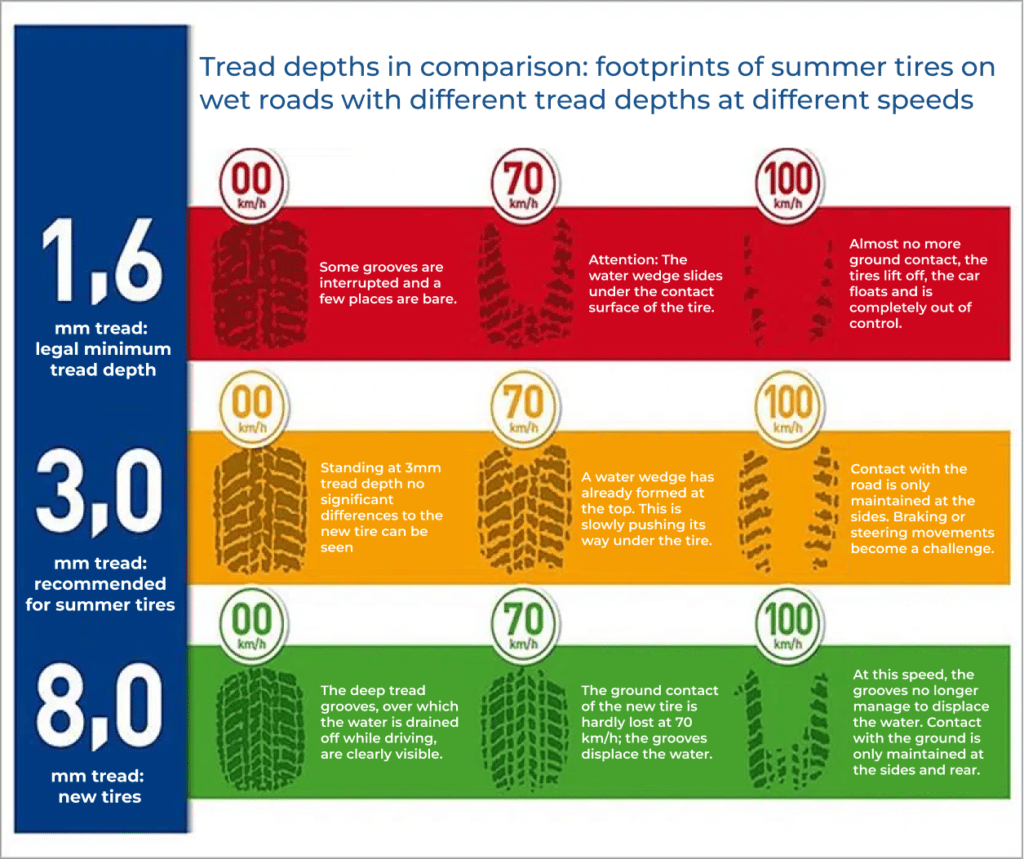Tires are among the safety-relevant parts of a motor vehicle. They are responsible for transmitting the engine’s power to the road and ensuring that the vehicle does not lose traction when cornering. So for the safety of the driver, passengers and all other people involved in road traffic, regular inspection of tires is very important.
In this article, we will explain how to check tires and thus ensure the safety of the vehicle.
The Right Tire Pressure
Tires only perform optimally when you check the tire’s pressure regularly. You can check your car’s manual to learn more about this.
If your vehicle does not have this option, you can check your tire pressure at any gas station, as they often provide measuring devices and compressors without charge. In addition, you can buy an inexpensive tire pressure gauge at any hardware store or online retailer. This way, drivers can check their tire pressure before embarking on long trips.
Why Is Tire Pressure So Important?
Tire pressure has a significant influence on the general health of a vehicle. For example, an underinflated tire can shorten a tire’s lifespan by 25 percent, even if it’s by a 0.3 bar difference. In fact, tire wear can worsen exponentially at inflation pressures of 0.4 bar below the set point.
In some cases, the higher rolling resistance of tires will cause the vehicle to consume more fuel. Generally, a difference of 0.5 bar leads to significantly longer braking distances and cornering deteriorates massively. On longer journeys and at higher speeds, the tire is at risk of bursting due to overheating because it must flex more.
Also, problems can arise when tire pressure is too high. First, your driving comfort will deteriorate, and the high tire pressure will cause your tires to wear out unevenly (especially at the center). If this happens, you’ll experience longer braking distances due to the reduced contact area. It can also affect your cornering stability negatively.
Where Can I Find Get Information on the Right Tire Pressure to Use?
Your owner’s manual is the easiest way to get the correct tire pressure for your vehicle. Manufacturers also place stickers at various points on the vehicle to easily check your tire pressure.
Where can I find the tire pressure stickers on my vehicle?
- On the B-pillar of the driver’s door/passenger door
- In the glove compartment
- On the inside of the gas cap
These are the most common places.
However, if you can’t find information about the proper tire pressure to use in any of these places, there are other alternatives. Manufacturers provide information for different vehicle types and tire combinations on some websites.
WORD OF CAUTION:
The prescribed tire pressure always refers to cold tires. When driving, the tires heat up due to friction, so you should check your tire pressure when driving less than 2 kilometers and at a speed of up to 50 km/h.
Why Should You Check Your Tire Pressure Regularly?
Tires are exposed to weather conditions, and their temperature changes due to stress, affecting the tire pressure.
New vehicles are not excluded, as you should expect pressure loss due to their design. Also, climatic changes can exacerbate this problem. For example, if you fill your tires with 2.0 bar at 25º in summer, the air pressure decreases to 1.7 – 1.8 bar at -5º during winter. For this reason, it is best to check your tire pressure every two weeks.
ATTENTION:
According to the German Federal Statistical Office, over 1,000 traffic accidents occur in Germany each year due to technical defects in the tires.
How does having the correct tire pressure affect a car when driving? The answer is simple.
Tires must have optimum grip and this is not only important during acceleration. It can be dangerous if grip is lost when braking and driving around curves. Without having the correct tire pressure, the occupants of a vehicle may find themselves in dangerous situations and they’ll also put other road users in danger.
Let’s take a closer look at why having the correct tire pressure is important.

Optimum tire pressure ensures that the entire tire tread is in full contact with the road’s surface. The tread wears out evenly, so the tire achieves optimum mileage. Likewise, you can achieve optimum braking distance only when the tires have optimal contact with the road’s surface. As a result, you’ll achieve the best power transmission while getting the required grip around curves.

Excessive tire pressure leads to a concave tire surface, which means only some parts of the tire are in contact with the road’s surface. Consequently, your tires won’t have optimum grip, and they’ll wear faster at the center than on the sides. In addition, the car will experience longer braking distances and instability when driving around curves.

If the tire pressure is too low, you’ll notice a bulge on the tire’s surface and there’ll be minimal contact with the ground at the center of the tire. In this case, the tires will have less usable tread than they should.
You’ll notice that the tire wears on the sidewalls, and the vehicle will start to “float.” Next, your tires will start heating up more than usual due to the low air pressure, and you can’t achieve optimum braking distances.
Keep in mind that optimal tire pressure depends on the weight of your car.

Usually, most vehicle manufacturers give two or more conditions to get the correct tire pressure. In most cases, the first condition comes to play when driving the vehicle with 2 passengers and some light luggage.
If more people are transported with more luggage, the vehicle’s total weight will increase accordingly. In this case, your tires need to have higher pressure to ensure an optimal driving experience. Most manufacturers specify the required tire pressure for loaded vehicles in the manual or on a sticker in the vehicle.
Also, note that you must adjust your tire pressure if you’re towing a trailer or caravan with the vehicle.
REMINDER.
Tire pressure affects the handling and grip of a vehicle. Therefore, the vehicle can only achieve optimum braking distance and mileage when its tires are at optimum pressure. In this regard, overinflated or underinflated tires pose a safety risk and can lead to accidents.
Vehicle inspection — what the wear pattern can tell you regarding the condition of the vehicle
If you are buying a used car, keep an eye on the tire’s wear patterns
When inspecting a motor vehicle, pay special attention to the “wear pattern” of the tires. When buying a used car, it can indicate problems with the steering or the chassis, which can still lead to higher costs later.
Even with a rental car, it is essential to check the wear pattern to see if the car is safe to drive. And of course, it makes sense to check your personal vehicle frequently to ensure its safety.
Why Is a Tire’s Wear Pattern Important?
Tires wear out due to persistent contact with the ground. Usually, the entire tread of the tire should be in contact with the ground to ensure perfect grip. This is very important, especially when braking and cornering.
However, when the tire pressure is too high or too low, the tires start to wear out partially. In addition, incorrect axle adjustment can cause the tires to have little contact with the ground. As luck would have it, the tire’s wear pattern can help identify these problems.
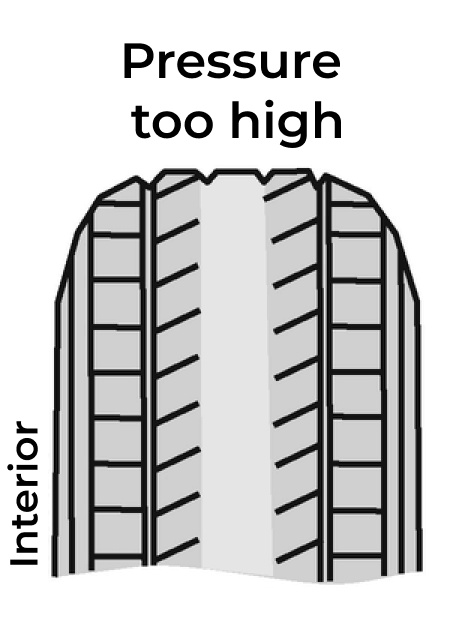
Excessive tire pressure can cause the tire to make contact with the ground at the center of the tread. In the long run, this leads to above-average wear at the center of the tire. This is because a relatively small area must transmit the forces that come into play while braking, acceleration, or cornering.

And again, if the air pressure is too low, only a small part of the tread is in contact with the road, and it causes the tire to wear out – especially on the sidewalls of the tread. Also, underinflation poses danger for the vehicle since the tires use a small part for grip, which can lead to problems.
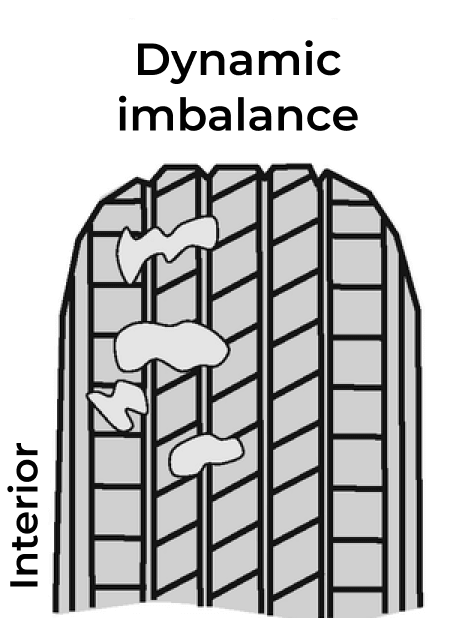
If uneven tire wear is detected, it may be the result of unbalanced rims. A similar picture also arises if the shock absorbers are defective or if there are problems with the brake system. If the tires lock during braking, heavy wear on the tires can be detected in places.
Problems with the Suspension Settings
Manufacturers have designed suspension settings for optimum road holding. Test drives have been used to get the settings that guarantee optimum safety and the best comfort while riding. This includes the track setting, which ensures optimum straight-line stability and cornering.

When there have been changes to the chassis, you need to carry out a track check. This includes different shock absorbers or new rims with different dimensions (offset, width, etc.) and wider tires.
Changes to the track setting can cause the tires to wear on one side and prevent the tires from maintaining optimum grip.
Additionally, the vehicle’s handling can also detect incorrect toe adjustment.
As a result, the car may pull to one side or the vehicle may not align straight after cornering without assistance.
Load Pattern of the Tires in the Event of Problems with the Track Setting
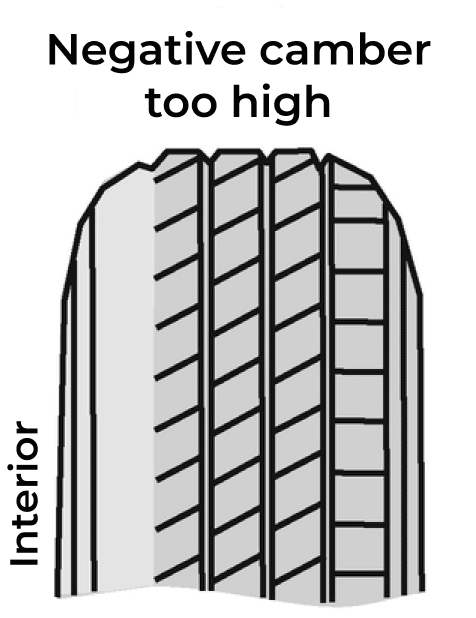
If the negative camber is too high, you’ll detect severe wear on the inner side of the tire contact pattern. This can happen on one tire or both tires. You can detect this on used or older vehicles if parts of the steering system are defective or improper repairs have been made.
When cornering, a slight negative camber is common on all passenger cars to allow higher lateral steering forces. The track geometry changes over the suspension travel on vehicles with independent suspension. The geometry remains the same on rigid axles over the entire suspension travel.
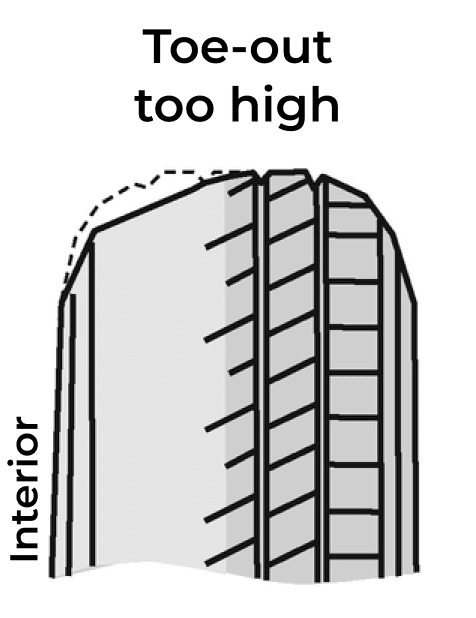
You can also recognize excessive toe-in by the tire’s contact pattern if you notice exceptionally high wear on the inside of the tires. This is because it runs in a straight line compared to the contact pattern of an excessively high negative camber. In addition, you can improve driving stability by the toe-out on the rear wheels.
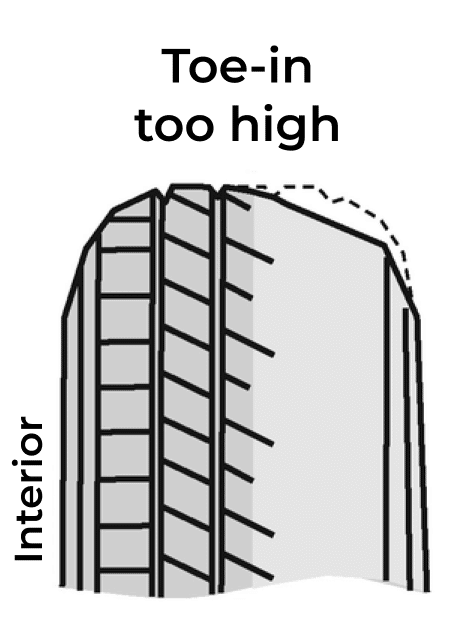
You can detect excessive toe-out by the tire’s wear pattern if you detect excessive high angled wear outside the tire. Also, you can detect changes in the vehicle’s handling because only a part of the tire is in contact with the road.
Wear pattern saw tooth formation
Sawtooth formation is a unique form of tire wear. It is primarily caused by defective shock absorbers or incorrectly adjusted axle geometry. While sawtooth formation is a normal wear phenomenon on motorcycles, it can indicate technical problems in passenger cars.

Sawtooth formation is caused by the load on the individual tread blocks on the road’s surface. When rolling, they are compressed and relieved again. This causes a slippage at the rear edge of the block, which does not wear the same way as the rest of the tread block. You can feel it with your hands by stroking the tread in the direction of travel.
Additionally, it often reduces ride comfort. In extreme cases, sawtooth formation can lead to the unstable tires. To some extent, you can counter sawtooth formation by swapping the front tires with the rear ones. However, it does not work on vehicles with constant four-wheel drive. Furthermore, you cannot do this on vehicles with “mixed tires” e.g., larger/wider tires on the rear axle.
Important Note
If you notice a problem with the contact pattern of your tires, you should consult a professional workshop. Only trained professionals should make adjustments, as incorrect adjustments can pose serious safety problems.
Safety factor — Tire tread depth
Worn tires can pose a serious safety problem. For this reason, you should check your tires at regular intervals. Minimum tread depth is important, especially in the rain.
What does the law say about tire tread depth?
In Germany, tires are not considered roadworthy if they don’t have a tread depth of at least 1.6 mm, which is at least over 2/3 of the tread. In Germany, if the authorities catch you with tires that don’t have a tread depth of 1.6 mm, you will be fined 120 euros.
Also, you may be partially at fault if there’s an accident, as your tires may have caused it in some way. Even if the accident is primarily the other party’s fault, this is still valid. Other European countries require a minimum tread depth of 4 mm.
The legislators in Germany have made it the driver’s responsibility to control the tread depth of a tire. This means that if you are caught with a tread depth below 1.6 mm, you will get a point on your license, and you will have to pay the fine even if it is not your vehicle. Therefore, you should always check the tires of borrowed vehicles.
More Safety-relevant Aspects of Tires
Tread depth is undoubtedly an essential factor in ensuring road safety. However, you should pay attention to other factors when checking your tires.
Maximum Recommended Tire Age
Nowadays, a modern car tire consists of about 25 components. They are rubber, steel, and textile. However, the lion’s share is rubber with up to 40%. Therefore, the mixture of modern tires can be complex, depending on the purpose they were manufactured.
Even though there is no legal requirement for the maximum age of tires, rubber, in particular, is subject to a natural expiration date. In general, the maximum age of tires is 10 years. However, for safety reasons, tires on sporty and high-horsepower vehicles should be replaced every 6 years. On regular passenger cars, it should be changed at least every 8 years.
Also, with new tires, you should pay attention to the age. Due to storage, dealers offer tires that are often several years old. Normally, “new” tires should not be older than 2 years. Dealers and tire manufacturers ensure various types of tires are available with long storage.
How Can You Determine the Age of Tires?
The production date is a part of the DOT designation that must be indicated on each tire. It consists of four numbers, where the first two represent the calendar week, and the last two digits represent the year.
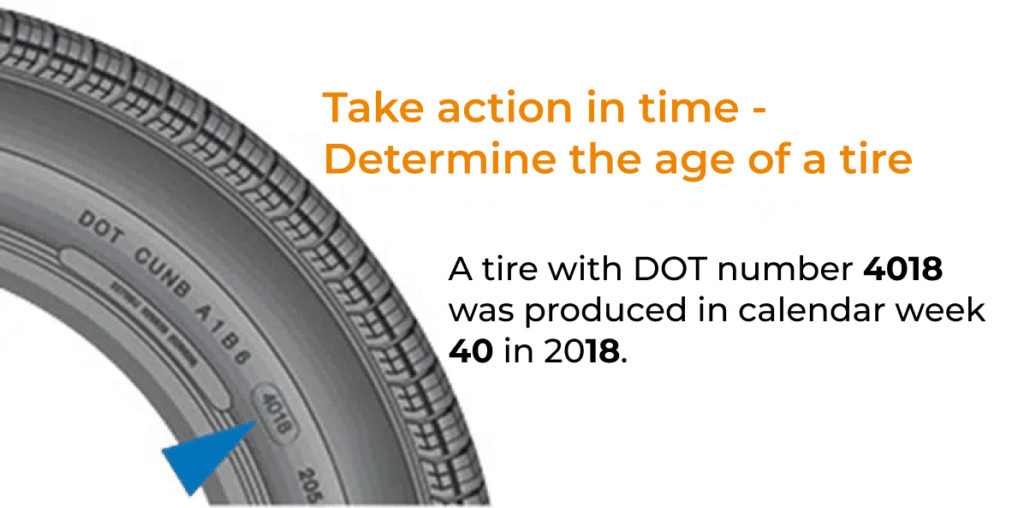
Damage to the Tires
While checking the tread depth, you should also inspect the tires directly for other damages. There are many reasons why tires can get damaged. Common types of damage are cracks, holes, breaks, bulges, or uneven wear.
Impact Fractures or Bulges

An impact fracture occurs when the tire’s carcass (i.e. fabric inside the tire) is damaged. For example, when a driver drives over obstacles, they’ll notice a bulge on the tire’s sidewall, which is visible from the outside leading to impact fractures.
Some examples are curbs or speed bumps that have been driven over too quickly or at the wrong angle.
The carcass can be subjected to stress leading to a break in the individual cords. The extent of damage depends on the speed and angle you drive over the obstacle. You can avoid this type of damage by driving carefully.

If you ignore impact fractures or formations, you’re at risk of having a flat tire. In addition, the tread or plies may separate, and you’ll start seeing the disintegration of the tire’s sidewall.
Over time, the tire may lose pressure or even burst at high speeds.
Constrictions on the side wall

Sometimes, you can detect constrictions on the sidewall of a tire. Furthermore, you can detect small depressions and indentions, but they are harmless and do not negatively affect the tire’s performance.
In most cases, constrictions are superficial and are caused by embedded carcass threads covered by rubber. They give the tire stability and strength while transmitting the required force to the steering and brakes.
Overlaps in the carcass often occur during the production of tires, and you’ll see this when the tire is finished. Luckily, this doesn’t pose any safety problems. But to be on the safe side, a qualified professional should inspect the tire in question.
Cracks

Cracks occur in tires due to extreme external conditions. These include poor road conditions, protruding body panels, or sharp objects.
In some instances, stones or broken glass can be the culprit. A professional should check the tire if you notice any cracks on the tire’s surface. It’s possible the tire will need to be replaced.
Checking the Tread Depth of Tires
When inspecting your tires, checking the tread depth is crucial for the safety of your tires, especially if you can’t see any of the damages mentioned above.

You will find small ridges in the tread base in six places in the tire tread. These ridges are wear indicators.
If the tire merges into the tread blocks without a step, then it is already below the legal minimum tread depth. As shown in the picture, you should not use tires below the minimum tread depth on the road.

However, you can use a 1-euro coin to check the tread depth of your tires to ensure optimum safety. The golden edge of the coin is exactly 3 mm high, which makes it a perfect tool for checking tire wear. Simply insert the coin into a crack in the tread – preferably next to the wear indicators. If the golden edge of the coin is no longer visible, the tread depth is still okay.
Without delay, change the tires the moment you see the golden edge of the coin. Here’s an important fact you should always consider – even though legislators have set a minimum tread depth of min. 1.6 millimeters, the required tread depth for safe driving is set at 3 to 4 millimeters.
The Reason 3-4 Millimeters Tread Depth Is Required for Safe Driving
Although legislators have specified a minimum tread depth of 1.6 mm, safety problems can still come up at this tread depth. While in dry driving conditions, the contact area of tires with a low tread depth is relatively large, which can lead to safety problems when it rains, and the speed exceeds 70 km/h. This is because the tread depth of the tires is too small.
The reason for this is the tire’s ability to displace water through the grooves in the tread. While more water can be forced out through the grooves at a higher tread depth, the amount is insufficient at a low tread depth above certain speeds.
The tire then loses contact with the ground, which could make the driver lose control of the vehicle – this phenomenon is sometimes called aquaplaning. The higher the volume of rain, the more water the tires have to displace.
In the table below, you can see that even with a tire with a 3.0 mm tread depth from 100 km/h, the contact of the tire with the ground is very critical in the rain. Therefore, you should replace tires with a tread depth of 3 mm as soon as possible.
Tires are among the safety-relevant parts of a motor vehicle. They are responsible for transmitting the engine’s power to the road and ensuring that the vehicle does not lose traction when cornering. That’s why it is important that you regularly check your tires for the safety of the driver, passengers, and others involved in road traffic.
